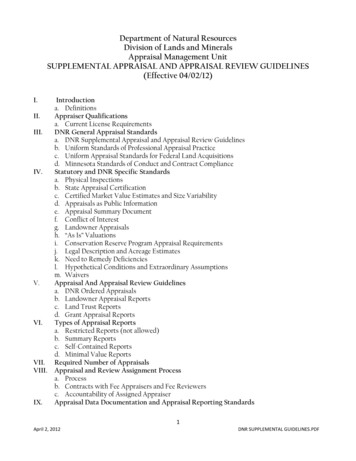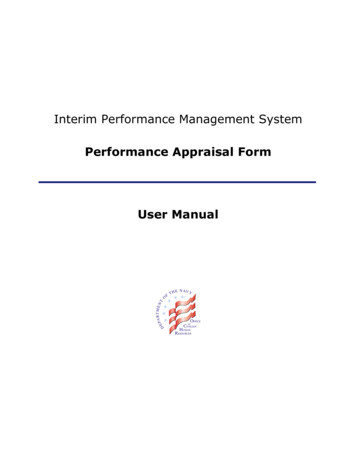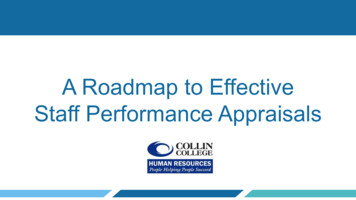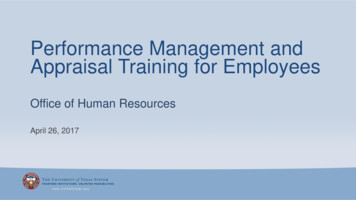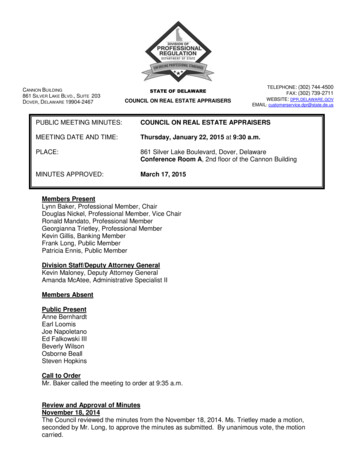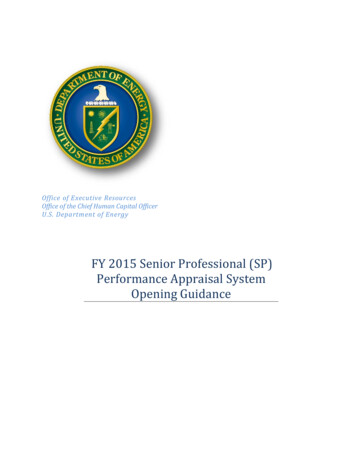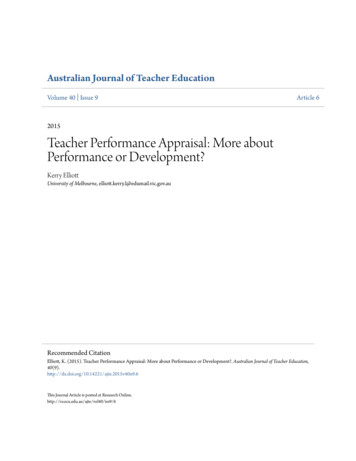
Transcription
Australian Journal of Teacher EducationVolume 40 Issue 9Article 62015Teacher Performance Appraisal: More aboutPerformance or Development?Kerry ElliottUniversity of Melbourne, elliott.kerry.l@edumail.vic.gov.auRecommended CitationElliott, K. (2015). Teacher Performance Appraisal: More about Performance or Development?. Australian Journal of Teacher 15v40n9.6This Journal Article is posted at Research Online.http://ro.ecu.edu.au/ajte/vol40/iss9/6
Australian Journal of Teacher EducationTeacher Performance Appraisal: More about Performance orDevelopment?Kerry ElliottThe University of MelbourneAbstract: Given that “teacher appraisal can be a key lever forincreasing the focus on teaching quality” (OECD, 2013b, p.9) andthat many reforms in the past have failed (Kleinhenz & Ingvarson,2004), an understanding of the various aspects of successfulperformance appraisal is essential. The literature has begun to referto a number of factors that support the development of an effectiveperformance and development system. This paper discusses some ofthe key research connected with teacher performance appraisal,including aspects and outcomes and points to the need for a betterunderstanding of how they are connected to bigger ideas.Highlighting the importance of an enhanced understanding ofperformance appraisal as a discursive approach to building teachingquality, this paper identifies elements that need further research if weare to grasp the implications of performance appraisal.IntroductionEnhancing achievement and providing a quality educational experience for allstudents has long been the most important outcome expected of schools. With evidencesuggesting that “teacher quality is the single most important school variable influencingstudent achievement” (Organisation for Economic Cooperation and Development [OECD],2005, p.26), the key role teaching and teachers play in enhancing student achievement isrecognised. Given that “teacher appraisal can be a key lever for increasing the focus onteaching quality” (OECD, 2013b, p.9) and that many reforms in the past have failed(Kleinhenz & Ingvarson, 2004), an understanding of the various aspects of successfulperformance appraisal is essential.Performance appraisal can be defined as the ongoing process used for identifying,measuring and developing an individual’s performance in accordance with an organisation’sstrategic goals (Aguinis, 2009). Appraisal may involve formative aspects that focus ondeveloping performance, such as career development, professional learning and feedback.Summative aspects, on the other hand, evaluate performance for career progression, possiblepromotion or demotion and termination purposes.When used for both accountability and instructional improvement, performanceappraisal that identifies and enhances teaching quality may be considered the ideal qualityassurance mechanism (Danielson & McGreal, 2000). The OECD (2009b) acknowledge that:Raising teaching performance is perhaps the policy direction mostlikely to lead to substantial gains in student learning. It is essentialto know the strengths of teachers and those aspects of their practicewhich could be further developed. From this perspective, theinstitution of teacher evaluation is a vital step in the drive to improveVol 40, 9, September 2015102
Australian Journal of Teacher Educationthe effectiveness of teaching and learning and raise educationalstandards (p.3).As the intensity of change quickens and the emphasis on keeping up with itheightens (Day, 2013), greater transparency demands that school systems compete in aglobal economy. An effective performance appraisal system will, ideally, assist in meetingthese demands by holding employees accountable, addressing underperformance andenhancing performance and practice (Zbar, Marshall, & Power, 2007).This paper explores the challenges and opportunities afforded by performanceappraisal and its associated measures. Previous reforms will be outlined and followed by adescription of the National Performance and Development Framework for Australianschools. As the first Australia-wide arrangement for teacher performance appraisal, its keyfeatures and the issues associated with implementing an effective performance anddevelopment system will be explored.By providing a review of key literature, this paper will identify those areas in whichfurther research is necessary if we are to better understand the intricacies of performanceappraisal.Defining Quality: Adopting StandardsStandards describe actions and performance thus outlining the functions ofindividuals within a profession (Celik, 2011). For teachers, standards attempt to definequality teaching. Ranging from generic to subject-specific attributes, they outline what ateacher should know and be able to do. Standards are used in many performance appraisalschemes to evaluate and guide teacher development (Kennedy, 2010), with a generalagreement that standards and a shared understanding of quality teaching are foundations ofany effective appraisal system (OECD, 2013b).Research in the late 1980s and early 1990s saw a focus on teacher quality and theprovision of quality teacher education programs (Ingvarson, 2010). Australia was not alonein the promotion of quality teaching, with the adoption of rigorous standards figuringprominently in public debate in the United Kingdom and United States (Louden, 2000;Sachs, 2005).Tensions associated with the development of exemplary standards (alongside aproliferation of professional associations, national boards and agencies) meant that variousgroups, including teaching and subject associations, competed to represent the profession.While many developments were driven by a desire to increase the ‘professionalism’ ofteachers and teaching, standards that reflect the intricacies of teaching, ‘allowing it to be theart as well as the science’ (Phillips, 2012) was-and is-a complex matter. Although standardsare important, Darling-Hammond (1994) cautioned against policy that focused solely onintroducing standards and claimed that it is not so much the standards that would improvethe education system, but how the standards were used.Within the performance appraisal process, standards provide scope for teachers andschool leaders to make informed decisions about teaching performance and may assist inidentifying future areas for growth and development. In Australia, a description of whatconstitutes teaching quality is encapsulated in the Australian Professional Standards forTeachers (Australian Institute for Teaching and School Leadership [AITSL], 2011).According to the Australian Institute for Teaching and School Leadership (AITSL),standards aim to articulate expectations for teaching, foster consistency and accountabilityand serve as the foundation for performance review at the end of the appraisal cycle.Vol 40, 9, September 2015103
Australian Journal of Teacher EducationThe Effectiveness of Performance AppraisalPerformance appraisal research falls into three main groups: the first group examinesthe variations in student learning from teachers within the appraisal process, the secondevaluates teacher perceptions of the impact of the process on their practice and levels ofmotivation and the third evaluates effective performance appraisal conditions (Isore, 2009).VariationsThe first body of research compares outcomes for students whose teachers haveparticipated in performance appraisal with those that have not. A sub-set compares studentoutcomes against results from the teachers’ appraisals to determine whether the process wassuccessful in identifying teacher quality. This body of research often draws on Value AddedMeasures (VAM), which aim to measure the teachers’ contributions to student outcomes bycomparing current test scores with test scores from the same students in previous years, aswell as with scores of other students at the same grade level (Isore, 2009).Although VAM have gained in popularity over the last decade as tools for measuringteacher effectiveness (Berliner, 2013; Konstantopoulos, 2012), they are unlikely to providethe solution to building teacher capabilities (Valli & Finkelstein, 2013). A failure toacknowledge the many aspects that contribute to teacher quality and student outcomes(OECD, 2005) - including the role school, peers, former teachers, pre-service programs andexperiences play - makes VAM problematic (Berliner, 2013). Using student test results asthe sole means of evaluating teacher quality is contentious (McArdle, 2010). Masters (2011)cautions that “when performances are evaluated only in terms of measured results,employees and organisations find ways to ‘game the system’” (p.1).While VAM may be difficult to correlate directly to the teacher, the Measures ofEffective Teaching (MET) study (Gates Foundation, 2010) points to significant progress inthe use of VAM. Used alongside additional sources of data, VAM are more likely to predictthe effectiveness of a teacher and teaching and may offer, “a more accurate and nuancedview of the relationship among teacher qualifications, characteristics, practices, and studentachievement growth” (Goe, 2013, p.238).The National Board for Professional Teaching Standards (NBPTS) voluntarycertification process in the United States is a performance appraisal system that bothdevelops and recognises (through certification) quality teaching. While some evidencesuggests that students of teachers who obtain certification through the NBPTS system dobetter on standardised tests than students of non-certified teachers (Goldhaber & Anthony,2007; Smith, Gordon, Colby & Wang, 2005) other research suggests that there is littledifference between the two (McColskey & Stronge, 2005; Sanders, Ashton & Wright,2005): on balance, the NBPTS process appears to have a significant impact on teachers andthe students they teach. A meta-analysis (Compensation Technical Working Group, 2012) ofthe NBPTS system concludes that students taught by a certified teacher more often than notoutperform students taught by a non-certified teacher.Although there is evidence that supports a connection between teacher appraisal andstudent outcomes, research findings linking student outcomes directly to the evaluation ofteachers vary (Isore, 2009). Explanations for varied results may be explained byinconsistencies in teacher ratings from school to school and from one year to the next(Darling-Hammond, Amrein-Beardsley, Haertelz, & Rothstein, 2013), or the shortcomingsof linking student outcomes solely to the teacher.Vol 40, 9, September 2015104
Australian Journal of Teacher EducationTeachers’ PerceptionsThe second group of studies evaluating the effectiveness of performance appraisalfocuses on teachers’ perceptions of the effect of the appraisal process on their motivationand practice. Lustick and Sykes’ (2006) evaluation of the NBPTS found teachers involved inthe certification process went on to apply what they had learnt in the classroom and had anewfound enthusiasm for teaching and learning. The OECD’s Teaching and LearningInternational Survey (TALIS) which involved 90,000 secondary teachers and principalsacross 24 countries found that the greater the emphasis placed on a specific aspect ofteaching in the feedback offered through the performance appraisal process, the greater theimpact teachers believed it had on their teaching (OECD, 2009a). This provides usefulinsight into the formative aspects of appraisal and the extent to which teachers believe theprocess assists in developing their practice.ConditionsThe third group of studies examines conditions under which performance appraisal islikely to operate effectively (Isore, 2009). According to the OECD, there are four keyelements in the development of an effective performance appraisal system (Isore, 2009):1. Teachers are involved in the process. Evidence suggests that this promotes greaterownership and encourages reflection and review among the teachers themselves(Kleinhenz & Ingvarson, 2001).2. Stakeholders understand the process and develop a common language of quality.3. Teachers have opportunities to express their perceptions and concerns throughout theprocess. Kennedy (2005) argues that teachers often reject reforms, not because they donot want to change or improve, but because many attempts at reform do not reflectwhat is actually happening in schools and ignore the realities of day-to-day teaching.4. Teachers have confidence in the evaluation. The participation of multiple evaluatorsand sources of evidence is essential to an appraisal system’s credibility (Stronge &Tucker, 2003).The impact of performance appraisal on teaching and student learning is complex. It is clearthat a diverse range of evaluations is necessary to measure the effectiveness of performanceappraisal accurately and to determine its credibility as a means of developing teachers.National and International ReformsSignifying acceptance of the essential role of the teacher in the development ofhuman capital (Groundwater-Smith, Ewing & Le Cornu, 2007), reforms in the late 1990sand early 2000s continued, fuelled by greater school comparisons, choice and internationalcompetitiveness (Cochran-Smith, 2010; Connell, 2009; Kelly, 2012). Economic planning,further research and corresponding policy developments (Valli & Finkelstein, 2013) saweducation policies move “toward a stronger focus on accountability and on careful analysisof variables affecting educational outcomes” (Stronge, 2002, p.viii).International comparisons through the OECD’s Programme for International StudentAssessment (PISA), the International Study Centre’s Trends in International Mathematicsand Science Study (TIMSS), the Progress in International Reading Literacy Study (PIRLS),the Global Entrepreneurship Monitor (GEM) and national comparisons through initiativesVol 40, 9, September 2015105
Australian Journal of Teacher Educationsuch as My School (launched in 2011 to provide greater transparency between Australianschools) made it possible to judge educational outcomes within and between school systems.With evidence suggesting “that the main driver of the variation in student learning atschool is the quality of the teachers” (Barber & Moushed, 2007, p.12), the impetus tocompete in a global, knowledge-based market (Goodwin, 2010; Ingvarson & Rowe, 2008)highlighted the need for school systems to evolve and meet the demands of an increasinglyskilled workforce.During this period, a suite of national and international policies highlighting teacherquality agendas emerged. The National Commission on Teaching and America’s Futurereport, What Matters Most: Teaching for America’s Future (1996) and the No Child LeftBehind Act (2001) led reform agendas in the United States, while the OECD (2005) report,Teachers Matter, contributed to international discussion on professionalism, standards andteacher quality (Connell, 2009).In Australia, reports including Teaching Talent: The Best Teachers for Australia’sClassrooms (Dinham, Ingvarson & Kleinhenz, 2008) and the Melbourne Declaration onEducational Goals for Young Australians (Ministerial Council for Education, 2008)contributed to national dialogue around teacher and teaching quality (Connell, 2009;O'Meara, 2011).The Melbourne Declaration highlighted the agenda for Australian education reformand emphasised the roles teaching and teachers play for all students in accessing a qualityeducation. Evidence suggesting effective appraisal and feedback improve teacherperformance has driven many reforms. These reforms have included inspections bysuperintendents, various performance payment schemes and performance reviews conductedby school principals or external inspectors (Ingvarson & Chadbourne, 1997).While both formative and summative means may have their place withinperformance appraisal, research indicates a focus on development to be the most effective inimproving classroom teaching quality (Hay Group, 2012). A good performance anddevelopment process should both guide reflection and professional development and providea framework for making a point-in-time judgement and giving feedback for furtherdevelopment. For many general critics of education, however, performance appraisal is oftenabout judgement.Many performance appraisal systems are weighted heavily toward accountabilityrather than the growth and development of teachers and their teaching practices (Bartlett,2000). Many performance appraisal systems have failed to inform teachers about what needsto be improved or supported their development to do so. A study by Weisberg, Sexton,Mulhern and Keeling (2009), The Widget Effect: Our National Failure to Acknowledge andAct on Differences in Teacher Effectiveness reported that of the 15,176 teachers surveyed,75 per cent believed that nearly all teachers received high ratings (good or great) during theappraisal process and that poor performance rarely led to teacher dismissal. Less than half(43 per cent) believed that performance appraisal practices actually helped teachers toimprove and that professional learning was rarely tied to the process (Weisberg et al., 2009).Other teacher-based surveys yielded similar results, with 69 per cent of respondents in onestudy claiming performance appraisal was ‘just a formality’ (Duffet, Farkas, Rotherham, &Silva, 2008) and in another 63 per cent believing that appraisals were undertaken largely tomeet administrative requirements (OECD, 2009a).In Victoria, the Performance and Development Culture Accreditation Scheme,released in 2004 as part of the Blueprint reform in public schools, aimed to promote greaterconsistency between school’s performance appraisal processes - as each school soughtaccreditation and proved that their school had key performance and development processesVol 40, 9, September 2015106
Australian Journal of Teacher Educationin place. Teacher performance, according to the literature and to the Hay Grouprecommendations, improves when the following conditions are present: opportunities for teacher self-reflection and goal setting (Ross & Bruce, 2007); regular classroom observation and the provision of constructive feedback fromschool leaders or managers and peers (Avalos, 2011); frequent feedback on classroom performance as an ongoing dialogue not an annualdiscussion (Wang, 2007); shadowing, coaching and mentoring from peers and leaders (Steckel, 2009) and opportunities to contribute to and engage in teamwork, collaboration and actionlearning with other teachers (Bean, 2007).The majority of public schools in Victoria (98 per cent) were accredited in the years thatfollowed the reform with some evidence suggesting that the performance and developmentaccreditation process led to a more consistent approach to teaching practice (Starr, 2009).There is, however, little evidence to suggest that this process improved the quality ofteaching or led to long lasting change (Kamener, 2012).Many practitioners, researchers and policy makers would agree that most teacherevaluation and appraisal systems do little to help teachers improve (Darling-Hammond et al.,2013). Findings in Australia, including those outlined by TALIS (OECD, 2009a) and Jensonand Reichl (2011) suggest that neither feedback nor valid performance appraisal areprovided consistently in Australian schools.As part of the agenda to drive quality teaching in all Australian schools, AITSL hasintroduced a National Performance and Development Framework that outlines key aspectsof a performance appraisal process and emphasises that all teachers should undergoperformance reviews (Dinham, 2013). Perhaps in a bid to move away from an overemphasis on evaluation - now considered part of an outdated definition of performanceappraisal - the National Performance and Development Framework outlines the process forboth evaluating and developing teachers.Key Features of Effective Performance AppraisalAITSL’s National Performance and Development Framework encompass bothformative and summative aspects of appraisal. Alongside registration, accreditation andcertification processes the framework seeks a consistent approach towards teacherperformance and development to develop, retain and advance teachers. AITSL propose threebroad phases of school performance appraisal: reflection and goal setting, professionalpractice and learning and feedback and review.Reflection and Goal SettingReflection and goal setting are key drivers for improvement within the AITSLframework. During this phase teachers were asked to reflect on their teaching practice,informed by evidence and feedback, and set measurable goals related to their performanceand development. Bandura (1997), acknowledges an important source of motivation comesthrough goal setting and self-efficacy, with efficacy determining the type of goals peoplechoose and their ability to persist on tasks. Goal setting and reflection have been found tohave a powerful impact on action (Locke & Latham, 2002). The setting of goals is central tothe development of a self-regulated learning capacity and assists teachers to identify whatthey need to do to improve their practice (Timperley, 2011).Vol 40, 9, September 2015107
Australian Journal of Teacher EducationProfessional Learning and PracticeThe next phase of the framework has been identified as a significant method ofimproving performance. It involves access to professional learning to support teachers asthey work toward their goals.Professional learning signifies a shift in thinking away from the “perceptions andpresumed ‘baggage’ associated with poorly conceived, fragmented, one-shot and decontextualised in-service workshops” (Mayer & Lloyd, 2011, p.3) to a predominantlyschool-based, ongoing learning process that is linked directly to teachers’ work (Hawley &Valli, 1999).According to Yoon, Duncan, Lee, Scarloss and Shapley (2007), professional learningaffects student achievement in three steps, as outlined in Figure 1.ProfessionalLearningTeacherknowledgeand skillsClassroomteachingStudentachievementFigure 1: Professional Learning - Effect on Student AchievementProfessional learning enhances teachers’ knowledge and skills, leading to improved teachingand improved teaching raises student achievement. While these causal effects have beenidentified, the challenge is in evaluating student achievement as a direct consequence of theprofessional learning.Drawing on various studies (Hattie, 2009; Timperley, Wilson, Barrar & Fung, 2007;Yoon et al., 2007) effect size methods - used to compare results from students over time andbetween groups - assist in measuring the impact of professional learning on studentachievement. For example, Yoon et al. (2007) examined nine studies that measured gains instudent achievement as the result of a professional learning activity and found the effectranged from 0.53 to 2.39, with 0.54 constituting the average. Similarly, Timperley et al.(2007) found effect sizes from 0.48 as reported in Phillips, McNaughton and MacDonald’s(2001) study, through to English and Bareta (2006) who described a writing professionallearning experience that reported effect sizes of up to 2.1 - for the lowest-achieving students.Among the 97 studies examined by Timperley et al. (2007), professional learning ledto significant improvements in student achievement when:1. Learning focused on student outcomes and demonstrated a link between the learningand its impact on student achievement.2. Worthwhile content was introduced that involve challenging and purposefuldiscourse.3. Learning involved the integration of knowledge and skills.4. What students needed to know and do was used to identify what teachers needed toknow and do.5. There was sufficient time to learn, practise and embed changes. Yoon et al. (2007),found the impact on student achievement was greater when programs offeredbetween 30 and 100 hours of professional learning and were spread over a six to 12month period. Darling-Hammond et al. (2009), claimed that teachers needed close to50 hours of professional learning in a given area to improve their skills and thus theirimpact on student achievement.6. Approaches were responsive to learning processes. Engaging teachers in the processand challenging their existing ideas and assumptions was important in developingcongruence between new information and practice.Vol 40, 9, September 2015108
Australian Journal of Teacher Education7. Opportunities were provided for teachers to process new learning and work on theirskills together.8. External expertise was sought and often necessary to challenge existing assumptions.9. Leaders developed expectations and promoted professional learning opportunities.10. Momentum was maintained to develop new knowledge, work on inquiry andteachers were provided with the support to do so.Some evidence suggests that effective professional learning may result in improvedstudent achievement, and, in some cases, substantial improvements (Timperley, Wilson,Barrar & Fung, 2007; Yoon et al., 2007). However professional learning’s average effect(0.51) does not place it into a high-stakes category of influence on student achievement(Hattie, 2009). “We know we need to get better at evaluating the impact of what we do –individually and collectively – and smart at using what the research can tell us about whatworks for diverse students in different contexts” (English, 2007, p.xiv). Improvements to thequality and quantity of evidence on professional learning’s impact on student achievementneeds to be a priority.Professional learning has taken a prominent position among educational policyemphases as a tool that invests in building teacher knowledge and skills (Ingvarson, 2003),and has been regarded as a key lever to improve teaching (OECD, 2005). A relationshipbetween appraisal and professional learning is essential for improving teaching practice, as“without a clear link to professional development opportunities, the impact of teacherappraisal and performance review will be relatively limited” (OECD, 2013b, p.62).Feedback and ReviewThis phase of the National Performance and Development Framework comprises offormal and informal feedback on performance. It usually includes a teacher being providedwith written feedback against their goals. During this phase, an evaluation of performance ismade against the agreed action plan and new objectives are set for the next review cycle.According to the 2009 TALIS report (OECD, 2009a), appraisal and feedback have astrong influence on teachers, increasing job satisfaction and improving teaching practice.Performance appraisal needs to provide feedback to teachers about their professionalpractice and offer opportunities for improvement. Although Donaldson and Donaldson(2012) report that teachers need constructive feedback from skilled practitioners in order toimprove their teaching, research suggests that feedback is often not a common occurrence inschools (OECD, 2009a; Zatynski, 2012). Just as students need feedback about performanceand progress, so to do teachers. Success criteria outlining what quality teaching looks like,informed by timely feedback about how to improve and in what areas, should surely be partof a continuous learning process for both teachers and students alike.Strengthening of the link between professional learning and performance appraisaland allowing for greater differentiation of professional learning to address the individualneeds of teachers are necessary. Given that performance appraisal helps teachers linkprofessional learning to standards and individual goals (Gilbert, 2011), understanding howthese fit together within an appraisal cycle is important.Next Steps – Performance or Development?Performance appraisal in education has not been without controversy. The evaluationof teaching and teachers is problematic (Kennedy, 2010) as too are the validity andVol 40, 9, September 2015109
Australian Journal of Teacher Educationreliability of the various evaluation methods (Darling-Hammond, Wise, & Pease, 1983).Mixed empirical evidence on the effectiveness of performance appraisal, a lack of validityregarding some performance measures and a conflict of interest between governmentsystems, has led performance appraisal, to be deemed, in many cases, a meaninglessexercise (Danielson, 2001; Marshall, 2005).Implementing valid performance appraisal systems in schools present a range ofchallenges (OECD, 2013a). To evaluate and improve teaching, a shared understanding ofquality teaching needs to be adopted. This in itself presents a challenge: do teachers usegeneric or subject-specific standards, or a mixture of both? Once these standards have beenagreed upon, how are teachers evaluated and assisted to develop, and by whom? Putting allthe weight of appraisal onto one person to carry out these duties without the necessarytraining or time to do so is likely to fail (Day, 2013). Attaining a balance between formativeand summative appraisal methods and understanding the dated language associated with thesystem being purely about assessing teachers is vital.A process that is seen as a means to ‘manage’ teachers needs to be reconsidered if acredible performance appraisal system is to be accepted by them (Ingvarson, 2012). Giveninitial talk of guiding ranges, ranking of teachers and balanced scorecards (AustralianEducation Union [AEU], 2013; Peace, 2013), the 2014 introduction of a new appraisalscheme in Victoria had a controversial inception. For:Rather than being done with and for teachers, many measuresadvocated and being hastily and poorly implemented in the quest toimprove teaching and learning are essentially being done to teachersand without their involvement, almost guaranteeing resistance,minimal compliance and inefficiency (Dinham, 2013, p.94).With little time for teachers to become familiar with a new appraisal system andlimited training to assist evaluators
An effective performance appraisal system will, ideally, assist in meeting these demands by holding employees accountable, addressing underperformance and enhancing performance and practice (Zbar, Marshall, & Power, 2007). This paper explores the challenges and opportunities afforded by performance appraisal and its associated measures.
